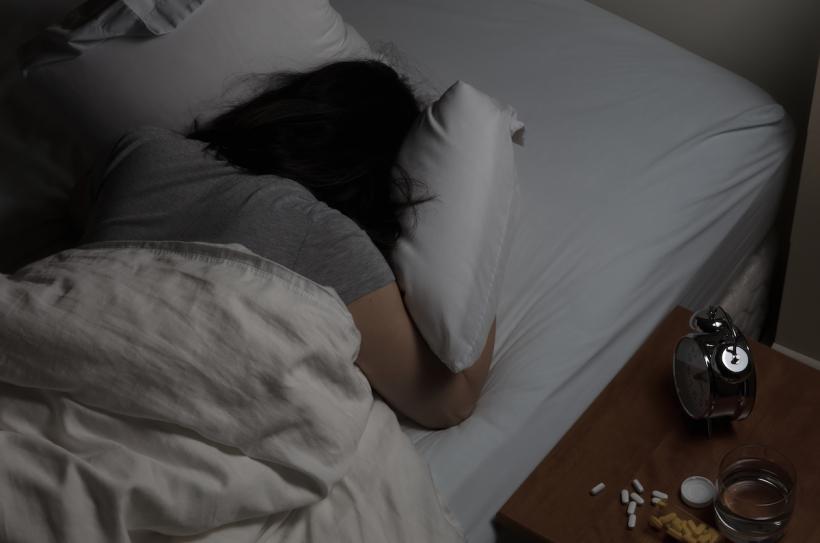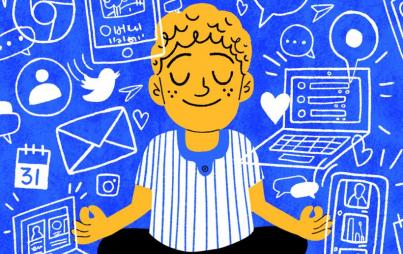
Long Reads is a bimonthly feature, showcasing long-form essays.
It’s 8:00 in the morning.
For seven years, my alarm goes off in the mornings, not so I can make it to work on time, but rather, so I can begin a marathon day of popping pills and swallowing the herbal tinctures that keep me moderately functional. Still groggy from the previous night’s cocktail of sleep medications, I stumble into my kitchen pantry, grab a handful of almond-flour crackers to prevent nausea, and gulp a multi-colored assemblage of prescriptions. Each pill assists my body with a duty it’s supposed to perform on its own. The human body is beautifully fashioned to fend off pathogens, regenerate tissues, and create energy. But somewhere along the line, my body went haywire, and now I struggle to keep my head above water as unexpected symptoms throw me for a loop each day.
Yesterday, an unrelenting twinge of abdominal pain appeared under my right rib cage and left me gasping for breath well into the early morning hours. I should have gone to the emergency room, but I have come to accept that life with a chronic illness is my unpleasant, unpredictable new normal. Plus, I’m burnt out by emergency room visits, hospitals, tests, and doctors.
“Treatment Fatigue” is the term I use to describe the state of mind when one can no longer rally the energy or strength for further medical interventions.
Likewise, I’m drained because tending to my disease consumes the bulk of my time, and the realization of all that I’ve lost to sickness and the years of burdensome treatments moves me to tears. How on earth did this happen?
The grief, pain, and misery of an illness lying in wait unsettles me — and yet, I must fight to sustain a life caught between existence and incessant stillness.
I have persistent (“chronic”) Lyme disease. Many doctors postulate this illness is simple to treat with a two to four-week course of antibiotics, but unfortunately, this illness is anything but simple. This merciless disease has all the makings of a nail-biting episode of a TV medical drama — convoluted symptomatology, inaccurate testing, baffled doctors, heavily disputed treatments, and heaps of medical and political controversy. All too frequently, doctors miss the diagnosis in its early stages, causing a patient’s health to decline until they become a remnant of themselves.
Often, I find myself haunted by the shadow of misery that is Lyme disease. From a place of deep despair, C.S. Lewis ascertained, “Part of every misery is, so to speak, the misery's shadow or reflection: the fact that you don't merely suffer but have to keep on thinking about the fact that you suffer. I not only live each endless day in grief, but live each day thinking about living each day in grief,” he wrote in A Grief Observed. The grief, pain, and misery of an illness lying in wait unsettles me — and yet, I must fight to sustain a life caught between existence and incessant stillness.
These abject emotions feel prickly and uncomfortable, like an itchy wool sweater I wore as a child, and I want to yank it off of myself.
I experience my first Lyme symptoms in 2010: fatigue, insomnia, dizziness, muscle spasms, blurry vision, weight loss, and burning throughout my nervous system. I take a 10-month medical leave from work and shuffle from doctor to doctor, but no one knows with certainty what’s wrong with me. The doctors toss around several possible diagnoses, and I try one drug after another. I swallow stimulants and steroids to improve my energy, supplements to boost my nutrition, and a combination of pills to force my body into sleep at night. The symptoms never subside, and sadly, I am involuntarily terminated from my job because I am too sick to return to work. As an added consequence, I lose my health insurance, furthering the difficulty of obtaining an accurate diagnosis. Regrettably, I wait an additional two years for a doctor to identify this mystery illness.
My alarm sounds, and it’s noon.
Although it’s sunny outside, it’s dingy in my bedroom because a thick, brown blanket covers the window to keep out the light. It’s 2012, and I am bedridden, my body slowly deteriorating as my muscles atrophy. I develop a sensitivity to light and sound, so I lie in darkness and silence as the days gradually tick by me. My husband has become my caregiver, and he does his best, but I can see he’s overwhelmed by this uninvited role. He tries to coax me into walking to the living room, but I am fearful my legs won’t hold me, and I’ll collapse to the ground. At last, I give in, and I make my way by holding onto bookshelves and chairs until I reach a mattress he’s put on the floor for me.
The Tour de France is on television — I can’t look at the screen, so I lie with my head facing away from it, and I listen to the low-pitched hum of the sports commentator, Phil Liggett. His inflections are soothing and don’t cause my brain to feel like it’s reverberating inside my skull like most others sounds. I don’t know much about the sport of cycling, but I know Bradley Wiggins wins the 2012 Tour de France championship and becomes the first British rider in history to achieve this title.
In stark contrast, Bradley Wiggins is at the top of his game; I am withering away in an alternate universe where the lives of the healthy and sick don’t intertwine. I watch from a distance as friends and family move on with their day-to-day activities, and I’m a forgotten piece of the past.
I’ve become a burden — my inability to care for myself makes it necessary for me to have someone with me around the clock. We purchase iPhones so I can text for help whenever I require it. But I’ve lost touch with everyone, and my dwindling list of phone numbers to enter consists of exactly four: my husband, my mother-in-law, my out-of-town mother, and one friend. I let out a visceral weep as a deep longing for human contact emerges within me.
But there is no one left to call. There’s only me and the four walls of a quiet, unlit bedroom.
By this time, I’m unable to stay upright for more than five minutes, so I establish what I call half-baths — I sit in the bottom of the bathtub, soap up, and rinse off, making sure to stay within the allotted five-minute time frame. More, and I become out of breath and feel faint. The next day, I complete the bath by kneeling at the side of the tub, resting my head over it, and washing my hair. For several months, I bathe in this atypical way twice a week.
My clothes drape off my skeleton-like frame, and I am freezing all the time. It’s 90 degrees outside, and yet, there’s a chill running through my body that penetrates to my bones. I layer myself in sweaters and fleece and bury my body beneath a down comforter, but it’s not enough to warm the icy feeling that’s coursing through me. My legs begin to jerk and shake in a violent, random manner. I am coherent, but I am powerless to make it stop, and I’m terrified of what’s happening to my body. I yell to my husband for help and he instinctively covers me with heating pads. Over the next hour, my body temperature steadily warms, and the shaking comes to a halt — at least for now.
While we were dating, my husband commented that he didn’t know if he’d be able to keep up with my always-on-the-go lifestyle. It’s a sudden and cruel twist of irony that I should find myself in an unfamiliar body that feels like it’s betraying me.
Insurance companies deny my request for coverage, so I remain uninsured and vow to avoid any further financial strain on my husband or parents. I hand-scribble a list of all the doctors I’ve seen and the medications I’m taking, and I prominently display it on my dresser mirror next to a photo of Caylie, my beagle. I issue specific instructions only to call an ambulance if I become unresponsive. If my body gives out, I want to make sure my husband is equipped to handle a harrowing situation.
As I sink lower into the hole of despair, my mother tells me she no longer recognizes my voice; it’s gotten deeper, and the words that come from my lips are forlorn and somber.
I give in to the unseemly thoughts running through my mind, and I begin to Google things like "dying with dignity" and "assisted suicide." I want to live, but my quality of life has reached an all-time low, and I'm searching for a way out of this miserable pit.
“It sounds like you’re asking me to grant you permission to die,” my mother says as I try to work this sordid topic into our conversation. “That’s not something I can do,” she tells me. From the recesses of my crumbling spirit, I cry out into the great abyss: How much longer must I live like this? My fragile hope is met with sounds of dead air, but I cling to a guarded prospect that I’m not beyond help.
It’s unfathomable for my family to believe there are no answers as to what’s making me sick. “You need to find the strength to try another doctor,” they tell me. My mother begs to visit me, but I keep telling her no; I can’t bear the thought of her seeing me in this frail and vulnerable state. I desire to shield her from this anguish as long as I can.
Before sickness, I had an adventurous life. I was a gymnast, an occupational therapist, a Pilates instructor, and a traveler. While we were dating, my husband commented that he didn’t know if he’d be able to keep up with my always-on-the-go lifestyle. It’s a sudden and cruel twist of irony that I should find myself in an unfamiliar body that feels like it’s betraying me.
A few months later, my mother and husband secretly hatch a plan for her to travel from Minnesota to Chicago to see me. While seated on a wooden bench in my dining room, I faintly detect my mother’s whispers in the stairwell leading up to my front door. It takes a minute for my brain to process her voice and confirm that I don’t hear it in error.
With soft steps, my mother enters my apartment and calls my name. We glance at each other and both begin sobbing. Emotionally and physically, I’m at my worst, and I consider for a moment that I may be unloveable.
My mother reaches through my insecurities and wraps her arms around me. Immediately, my instincts to insulate her from the ravages of illness quickly fade — I have misjudged her strength. She is capable of experiencing pain, yet unwavering in her support for me. Out of worry and shame, I’d pushed her away for a year-and-a-half, but her visit reminds me I’m not alone in this long-lasting trek, and her encouragement is a salve to my lonely heart.
It’s 4:00 in the afternoon.
Eventually, I seek the help of a doctor who specializes in the diagnosis of complex medical conditions. He’s warm and compassionate and spends two hours evaluating my medical history. Embarrassed that I can’t hold my body upright, I apologize for sprawling out in his office chair. He understands I can’t tolerate sound or light, so he respectfully dims his office lights and speaks to me in a calm voice. I’m tearful throughout the appointment, and he can tell I’ve been suffering for a long time. At the end of our visit, he tells me he believes I have Lyme disease, and it’s been misdiagnosed for years.
Shocked, I try to talk him out of the diagnosis and insist it’s impossible. I never noticed a tick bite or a rash, and I’d already tested negative for Lyme disease — not once, but twice before.
My mind tries to comprehend his words as he explains to me that approximately half of all people infected with Lyme disease have no recollection of a tick bite or develop a classic bull’s-eye rash. He describes the inaccuracies of testing, lists the other tick-borne infections that coincide with Lyme disease, and helps me understand how the previous healthcare professionals overlooked the illness in my case. “Lyme disease is ‘The Great Imitator’ due to its long list of symptoms, and its ability to mimic many other conditions," he informs me. For the first time in years, there’s a small glimmer of hope blossoming within my soul, and I leave with an aggressive treatment plan. The entire treatment comes with a massive out-of-pocket expense to my family and me, but what choice do I have?
Following the appointment, I watch YouTube videos and interact with people on Instagram who have been diagnosed with Lyme disease. Practically all of them are like me — working professionals in their twenties and thirties who were struck down by a mysterious illness in the prime of their lives. We share similar horror stories on the quest toward an accurate diagnosis, and, sadly, similar levels of debilitation from this affliction. Daily, I communicate with other patients through the growing network of support I discover from around the world. We call ourselves #Spoonies and #LymeWarriors, and I catch a glimpse of their daunting battle to return to health.
I grit my teeth and prepare to fight this destructive enemy; I resolve to overcome Lyme disease no matter what it takes.
Slowly, I introduce antibiotics, supplements, sleep medications, IV nutritional therapies, and a steroid to help my body retain salt. I make it out of the house for Thanksgiving with my in-laws, but other than that, the treatments make me sicker. My doctor explains that when high amounts of bacteria are killed off in the body, an inflammatory reaction can occur — which temporarily increases the symptoms. But the added stress is problematic for my body, and it rejects his regime despite my best efforts to slog through it.
Although these spurts of energy are short-lived, my glimmer of hope widens and begins to look more like a streak of light.
Soon, I’m in a constant state of fear and panic, and everything I ingest makes me wired. I add in a cholesterol-lowering medication that acts as an off-label toxin binder to assist my body in removing unwanted waste. But the medication backfires, and I begin to hallucinate leggy, salmon-colored bugs crawling on the kitchen walls. I know they’re not real — that the hallucinations are a side effect of the inflammation in my brain — but, after a year of treatment, I decide I’ve had enough.
My health continues to be poor, so I make the scary and uncertain decision to find a new clinician. Many years ago, I’d read about a Washington, D.C. nurse practitioner named Ruth Kriz. She specializes in the treatment of pelvic pain disorders and tick-borne infections — a unique combination of illnesses — both of which I endure.
I contact her office and schedule an appointment for the following month. As I await my appointment, I start acupuncture in an attempt to find some symptom relief. To my surprise, it helps, and I can sit and stand for two-hour increments following each session. My husband and I use these operative hours to have lunch together, sit in the sun, or go shopping. Although these spurts of energy are short-lived, my glimmer of hope widens and begins to look more like a streak of light.
My consultation with Ruth is constructive, and having dealt with Lyme disease herself, she presents intriguing, untried ideas. She orders several tests and lays the groundwork for an integrative treatment plan that consists of prescription medications, specifically-designed herbal tinctures, and a few select supplements to support my body in the healing process. She is confident and decisive in her approach to managing this illness. At 66 years of age, she assures me she’ll be around for a while. “I just signed a five-year lease on this building,” she says. And I’m comforted knowing I can rely on her expertise as I walk the journey toward recovery. To protect my emotional well-being, I ignore the haste with which others are doing their treatments. Once and for all, I stop measuring my progress against the achievements of my social media friends. Ruth instructs me to pace myself with this protocol and to add a new product only when I feel I’m ready for it.
Finally, It’s midnight.
I down my last round of pills to fall asleep and crawl into bed. Over the last several years, I’ve carried a supply of medications and herbal tinctures with me everywhere — the back of a cab, the middle seat of an airplane, a Chipotle bathroom, a Kate Spade dressing room, a Ferris wheel, and recently, in a canoe during a thunderstorm. They are my lifeline.
I don’t know if I’ll ever be “normal” again, but I no longer live each day in a state of endless grief. Instead, I find joy in the possibility of healing from this illness and creating a vibrant life for myself and my husband.
Though I’m not healed, I’ve regained 50 percent of my strength, and I’m learning to adapt to the limitations of a body that runs on a half-empty tank. As I approach the four-year treatment mark, I continue to consult with Ruth, and we’re determined to get this disease into remission. With conviction, I begin to feel as though I’m scaling up this enormous mountain — two steps forward, followed by a slide backward. Nonetheless, I progress along this steep climb.
I credit Ruth with saving my life from a complicated and destructive illness, and yet, I’ve never even seen her face.
Her expert guidance has taken place completely via phone consults — every lab test and medication sent through her computer. If it weren’t for her forward-thinking approach to healthcare for a population of chronically ill individuals, I might not be here today.
I don’t know if I’ll ever be “normal” again, but I no longer live each day in a state of endless grief. Instead, I find joy in the possibility of healing from this illness and creating a vibrant life for myself and my husband.
Tomorrow, my alarm will sound again. For now, I am at peace knowing I’ve done everything I can for my body and my health. As a new decade of my life approaches, I happily bid farewell to a long season of suffering and, with outstretched arms, embrace a refreshing season of endless possibilities.








